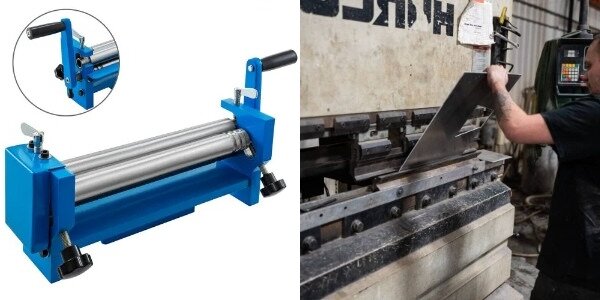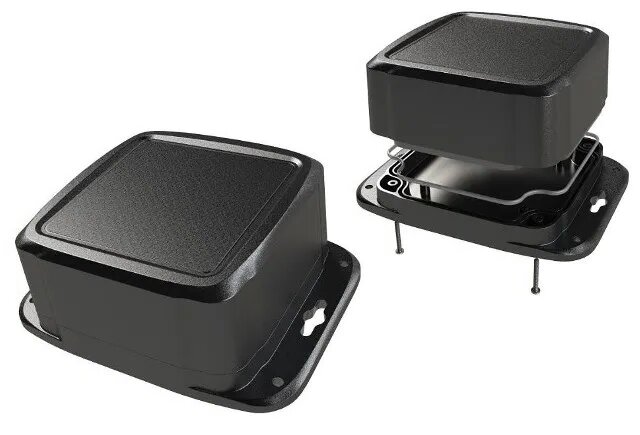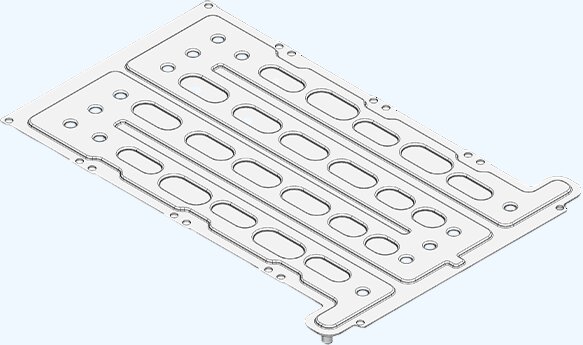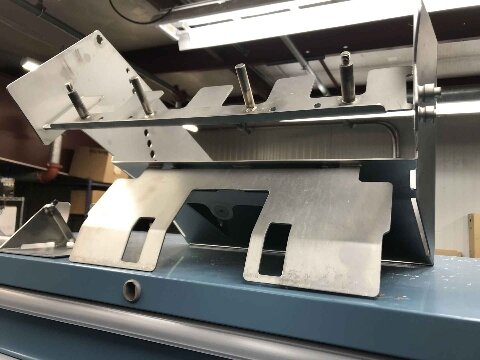Przy wyborze powłoki cynkowej dla części metalowych, rozróżnienie między typem I i typem II może mieć znaczący wpływ na wydajność, trwałość i koszty. Wielu inżynierów i producentów koncentruje się wyłącznie na ochronie przed korozją lub wyglądzie. Jednak wybór niewłaściwego typu może prowadzić do awarii części, zwiększonych kosztów konserwacji lub wyższych kosztów produkcji.
Ten artykuł wyjaśnia główne różnice między cynkowaniem typu I i typu II. Omówimy odporność na korozję, wykończenie powierzchni, koszty i wpływ na środowisko. Zobaczysz, który typ najlepiej pasuje do funkcji, kształtu i wyglądu Twojej części. W ten sposób można dokonać właściwego wyboru od samego początku.
Zrozumienie tych różnic pomaga uniknąć błędów. Zapewnia również, że części spełniają zarówno wymagania funkcjonalne, jak i wizualne. W kolejnych sekcjach omówimy podstawy cynkowania i podkreślimy kluczowe cechy powłok typu I i typu II.
Czym jest cynkowanie galwaniczne?
Cynkowanie to proces elektrochemiczny polegający na osadzaniu cienkiej warstwy cynku na powierzchniach metalowych. Głównym celem jest ochrona metalu przed rdzą przy jednoczesnym zachowaniu czystego, błyszczącego wyglądu. Grubość warstwy cynku wynosi zazwyczaj od 5 do 25 mikronów, w zależności od przeznaczenia części.
Proces ten ma kilka zalet. Poprawia odporność na korozję, nadaje gładkie wykończenie i stanowi dobrą bazę dla farby lub innych powłok. Jest również tańszy niż bardziej zaawansowane powłoki, takie jak nikiel lub chromowanie. Cynkowanie galwaniczne jest dostępne w różnych wykończeniach, w tym przezroczystym, niebieskim, żółtym, czarnym i oliwkowym, z których każde oferuje swój własny unikalny wygląd i poziom ochrony.
Ponieważ cynk jest stosunkowo miękki, nie zmienia on znacząco wymiarów części. Dzięki temu nadaje się do produkcji części precyzyjnych. Pomaga również wydłużyć żywotność części bez znacznego zwiększania kosztów produkcji.
Jak działa proces cynkowania?
Proces rozpoczyna się od przygotowania powierzchni. Części są czyszczone w celu usunięcia oleju, brudu i tlenków. Ten krok ma kluczowe znaczenie, ponieważ brud lub tłuszcz mogą powodować słabe przyleganie powłoki lub jej nierówności. Czyszczenie zwykle obejmuje odtłuszczanie, trawienie kwasem i płukanie.
Następnym etapem jest galwanizacja. Części są zanurzane w roztworze zawierającym jony cynku. Prąd elektryczny przepływa przez roztwór, powodując osadzanie się cynku na powierzchni metalu. Prąd i czas galwanizacji kontrolują grubość powłoki.
Po powlekaniu części są ponownie płukane i mogą być poddawane kolejnym etapom obróbki. Chromianowa powłoka konwersyjna może poprawić odporność na korozję i nadać kolor. Wypiekanie usuwa wodór, który może powodować kruchość stali o wysokiej wytrzymałości.
Na koniec części są suszone i sprawdzane, aby upewnić się, że powłoka jest równomierna i ma odpowiednią grubość. Prawidłowo wykonane cynkowanie tworzy mocną, jednolitą warstwę, która chroni przed rdzą i zużyciem środowiskowym.
Typowe zastosowania w różnych branżach
Cynkowanie galwaniczne jest wykorzystywane w różnych branżach ze względu na jego zdolność do osiągnięcia równowagi między wydajnością, wyglądem i kosztami. W przemyśle motoryzacyjnym chroni elementy złączne, nawiasyi drobny sprzęt przed solą drogową i wilgocią. W elektronice osłania złącza i obudowy bez wpływu na przewodność.
Producenci maszyn i urządzeń budowlanych stosują cynkowanie na narzędziach, śrubach i elementach konstrukcyjnych, które są często przenoszone lub narażone na działanie czynników zewnętrznych. Jest to również powszechne w urządzeniach gospodarstwa domowego, meblach i sprzęcie rolniczym, gdzie wymagane jest jasne wykończenie powierzchni i odporność na korozję.
Cynkowanie galwaniczne jest często stosowane z następującymi metalami:
- Stal
- Stal nierdzewna
- Miedź
- Mosiądz
- Aluminium
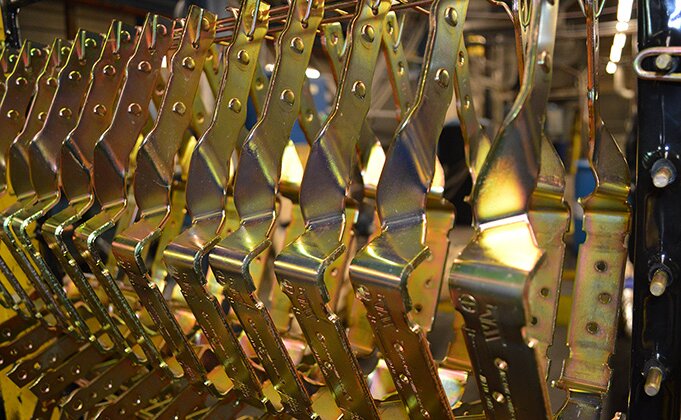
Odkrywanie cynkowania typu I
Cynkowanie typu I zazwyczaj wykorzystuje roztwór na bazie cyjanku do osadzania cynku na częściach stalowych lub żelaznych. Kąpiel cyjankowa pomaga stworzyć równomierną powłokę. Cyjanek jest jednak wysoce toksyczny, więc proces ten wymaga ostrożnej obsługi, odpowiedniej wentylacji i ścisłego zarządzania odpadami. Wymagania te mogą zwiększyć koszty operacyjne.
Sama powłoka jest prostą warstwą czystego cynku, bez obróbki konwersji chromianowej. Przygotowanie powierzchni jest mniej dokładne, więc nie wszystkie oleje, kurz lub pozostałości są usuwane. Oznacza to, że wykończenie może wyglądać szorstko lub nierówno, z drobnymi widocznymi niedoskonałościami.
Nawet w przypadku tych kosmetycznych problemów, powłoka nadal chroni przed utlenianiem i wydłuża żywotność części w suchym lub kontrolowanym środowisku. Ochrona jest bardziej praktyczna niż dekoracyjna.
Zalety powłoki galwanicznej typu I
Główną zaletą cynkowania typu I jest jego prostota. Zapewnia niedrogi i skuteczny sposób zapobiegania rdzy na częściach, które nie wymagają dekoracyjnego wykończenia. Proces ten tworzy niezawodną warstwę cynku, która spowalnia korozję, dzięki czemu nadaje się do komponentów ukrytych wewnątrz zespołów.
Działa również z różnymi rodzajami stali i umożliwia stałą kontrolę nad grubością powłoki. Dla producentów, którym zależy na równowadze kosztów i wydajności, powłoka galwaniczna typu I jest praktycznym wyborem dla podstawowej ochrony antykorozyjnej.
Typowe zastosowanie i ograniczenia
Powłoka galwaniczna typu I jest często stosowana na wewnętrznych częściach mechanicznych, łącznikach i wspornikach ukrytych wewnątrz zespołów. Najlepiej sprawdza się tam, gdzie funkcjonalność ma większe znaczenie niż wygląd, a środowisko jest suche lub łagodne.
Głównym ograniczeniem jest wykończenie. Brakuje mu połysku i gładkości, często wygląda matowo lub szorstko. Nie nadaje się do części, które wymagają polerowanego wyglądu.
Kolejną kwestią są obawy związane z ochroną środowiska. Kąpiele cyjankowe wymagają starannej kontroli w celu ochrony pracowników i zapobiegania skażeniu. Wielu producentów przechodzi na alternatywy bezcyjankowe, aby zmniejszyć ryzyko dla zdrowia i zachować zgodność z przepisami dotyczącymi ochrony środowiska.
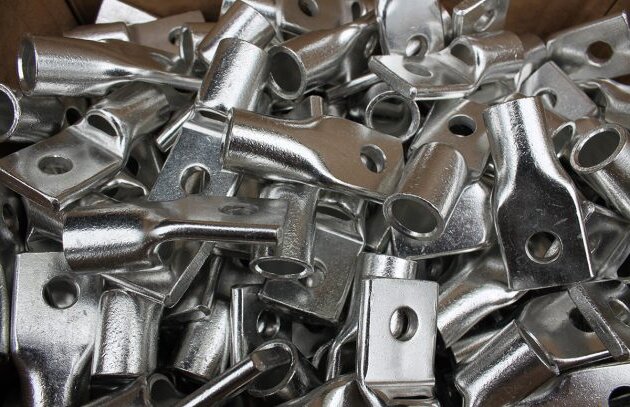
Odkrywanie cynkowania typu II
Cynkowanie typu II jest ulepszoną wersją podstawowej powłoki cynkowej. Dodaje warstwę konwersji chromianowej na wierzchu cynku. Warstwa ta, zwykle żółta lub opalizująca, pochodzi z obróbki chemicznej, która reaguje z powierzchnią cynku. Chromian uszczelnia powłokę, wypełnia drobne pory i spowalnia korozję.
Proces ten zapewnia gładsze i bardziej równomierne wykończenie. Najczęściej stosowanym kolorem jest żółty, ale można też stosować inne odcienie chromatyczne, w zależności od pożądanego wyglądu i wydajności. Chromian pomaga również zapobiegać powstawaniu białej rdzy, która może tworzyć się na cynku, gdy jest on wystawiony na działanie wilgoci przez dłuższy czas.
W porównaniu z powłokami typu I, powłoki typu II są grubsze, twardsze i trwalsze w trudnych warunkach. Lepiej przylegają również do farby lub innych wykończeń, jeśli wymagana jest dodatkowa obróbka powierzchni.
Zalety powlekania galwanicznego typu II
Cynkowanie typu II ma kilka zalet. Podstawową korzyścią jest lepsza ochrona przed korozją. Warstwa chromianu działa jak druga bariera, odporna na wilgoć, sól i chemikalia. Dzięki temu idealnie nadaje się do zastosowań zewnętrznych lub morskich.
Poprawia również wygląd. Wykończenie jest jaśniejsze, czystsze i bardziej jednolite niż typ I. Żółty chromian nadaje częściom profesjonalny, wysokiej jakości wygląd, dzięki czemu nadaje się do widocznych elementów.
Z punktu widzenia wydajności, powłoka typu II wydłuża żywotność części i zmniejsza potrzeby konserwacyjne. Działa dobrze w wilgotnym środowisku, a nawet oferuje pewne ograniczone samonaprawianie, jeśli powłoka ulegnie niewielkim zadrapaniom.
Typowe zastosowanie i ograniczenia
Powłoka galwaniczna typu II jest powszechnie stosowana w branżach wymagających zarówno trwałości, jak i estetyki. Wykorzystuje się ją w przemyśle motoryzacyjnym, lotniczym, budowlanym i elektrycznym. Elementy złączne, wsporniki, obudowy i części wyposażenia zewnętrznego to typowe zastosowania. Połączenie odporności na korozję i dobrego wyglądu sprawia, że jest to idealne rozwiązanie dla części, które muszą działać i dobrze wyglądać.
Typ II ma jednak swoje wady. Etap chromianowania zwiększa koszty i wydłuża czas przetwarzania w porównaniu z typem I. Wykorzystuje również chemikalia, które wymagają ostrożnego obchodzenia się i utylizacji w celu zachowania zgodności z przepisami dotyczącymi ochrony środowiska. Z czasem tarcie lub zużycie mechaniczne może zmniejszyć skuteczność warstwy chromianu.
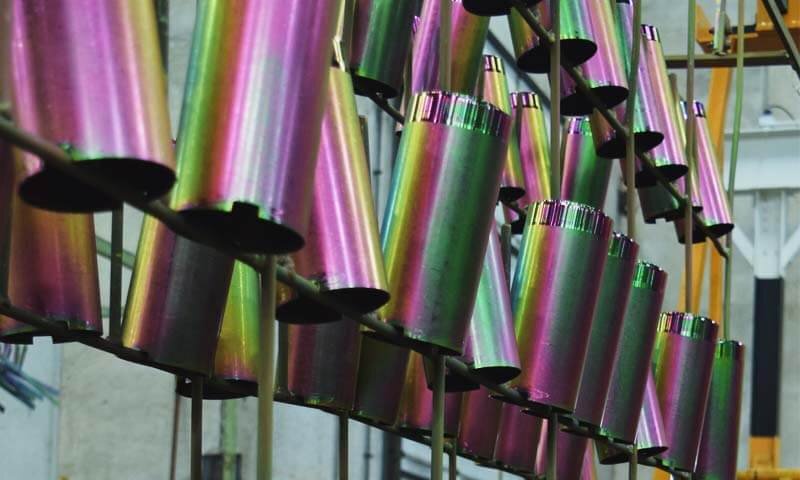
Kluczowe różnice między cynkowaniem typu I i typu II
Powłoki cynkowe typu I i typu II pokrywają metal cynkiem, ale różnią się pod względem wydajności, wyglądu, kosztów i wpływu na środowisko.
Odporność na korozję
Najważniejsza różnica polega na poziomie ochrony antykorozyjnej. Typ I spowalnia rdzewienie dzięki samej warstwie cynku. Działa dobrze w suchych lub kontrolowanych warunkach, ale jego żywotność jest krótsza w wilgotnym lub zewnętrznym środowisku. Wilgoć i powietrze mogą w końcu dotrzeć do metalu podstawowego, powodując powstawanie białej rdzy lub korozji.
Typ II dodaje chromianową powłokę konwersyjną na wierzchu cynku. Ta dodatkowa warstwa uszczelnia drobne pory i chroni przed utlenianiem. Może nawet częściowo "samoleczyć", co oznacza, że drobne zadrapania lub miejsca zużycia tworzą nowe warstwy tlenku. Typ II jest lepszy dla części narażonych na działanie wilgoci, soli lub zmiennych temperatur.
Wygląd
Typ I ma matowe, nierówne wykończenie, które może wyglądać na szarawe. Na powierzchni mogą pozostać małe cząsteczki lub niedoskonałości, ponieważ czyszczenie i trawienie są mniej dokładne. Jest on głównie funkcjonalny i używany do ukrytych części, gdzie wygląd nie ma znaczenia.
Typ II wygląda jaśniej, czyściej i bardziej jednolicie. Warstwa chromianu zapewnia gładką powierzchnię z żółtym lub opalizującym odcieniem. Wygląda profesjonalnie i jest idealna dla widocznych komponentów lub produktów konsumenckich. Dobre wykończenie pomaga również w utrzymaniu wysokiej jakości wizerunku produktów.
Implikacje kosztowe
Typ I jest zwykle tańszy, ponieważ obejmuje mniej etapów i materiałów. Sprawdza się dobrze w przypadku wysokonakładowej produkcji części wewnętrznych lub części o niskiej widoczności. Jeśli jednak używana jest kąpiel cyjankowa, koszty bezpieczeństwa i utylizacji odpadów mogą zmniejszyć część oszczędności.
Typ II kosztuje więcej ze względu na dodatkowy etap chromianowania i obsługę. Jednak dłuższa żywotność i mniejsza potrzeba przeróbek lub wymiany często sprawiają, że jest to warte swojej ceny. W przypadku części, które wymagają odporności na korozję w czasie, typ II oferuje lepszą wartość.
Wpływ środowiska
Typ I, szczególnie w przypadku kąpieli cyjankowych, może być niebezpieczny. Chemikalia te są toksyczne i wymagają starannego zarządzania odpadami i pracownikami. Wiele firm przechodzi na opcje bezcyjankowe; jednak surowe przepisy sprawiają, że zgodność z przepisami jest poważnym wyzwaniem.
Typ II ma swoje własne obawy środowiskowe z powodu związków chromianowych. Tradycyjne chromiany sześciowartościowe są toksyczne i podlegają ograniczeniom na mocy przepisów RoHS i REACH. Nowoczesne zakłady często używają trójwartościowych chromianów, które są bezpieczniejsze i bardziej przyjazne dla środowiska, chociaż ich kolor i wydajność mogą się nieznacznie różnić.
| Kategoria | Typ I | Typ II |
|---|---|---|
| Warstwa ochronna | Tylko podstawowa powłoka cynkowa | Powłoka cynkowa + warstwa konwersji chromianowej |
| Odporność na korozję | Umiarkowana ochrona, odpowiednia do użytku na sucho lub w pomieszczeniach | Wysoka ochrona, idealna do pracy na zewnątrz lub w trudnych warunkach |
| Wygląd | Matowa lub szorstka powierzchnia, czasami szarawa | Jasne, czyste i żółte lub opalizujące wykończenie |
| Przygotowanie powierzchni | Lekkie wytrawianie, może pozostawiać resztki oleju lub kurzu | Dokładne czyszczenie i obróbka zapewniająca gładszą powierzchnię |
| Wspólny elektrolit | Na bazie cyjanku (toksyczny, wymaga ścisłej utylizacji odpadów) | Bezcyjankowe lub na bazie kwasu z obróbką chromianową |
| Wpływ środowiska | Wysoka ze względu na użycie cyjanku | Umiarkowane chemikalia chromianowe wymagają odpowiedniej utylizacji |
| typowe aplikacje | Wewnętrzne lub ukryte komponenty, elementy złączne, wsporniki | Widoczne części, sprzęt zewnętrzny, motoryzacja, lotnictwo i kosmonautyka |
| Koszt | Niższy koszt początkowy, ale wyższe wydatki na bezpieczeństwo i kontrolę odpadów | Nieco wyższy koszt, ale lepsza długoterminowa ochrona i wygląd |
| Grubość wykończenia | Cienkie, zazwyczaj 5-10 mikronów | Nieco grubsze, zazwyczaj 8-25 mikronów |
| Zgodność z dyrektywą RoHS | Może nie spełniać wymagań ze względu na użycie cyjanku | Zgodność, jeśli używany jest chromian trójwartościowy |
Jak wybrać między typem I a typem II?
Wybór odpowiedniej powłoki cynkowej zależy od tego, w jaki sposób części będą używane, gdzie zostaną umieszczone i jaki będzie ich pożądany wygląd. Każdy typ ma inne przeznaczenie.
Geometria części
Kształt części może wpływać na to, który typ działa najlepiej. Powłoka typu I, wykorzystująca kąpiel cyjankową, ma doskonałą siłę wyrzutu. Równomiernie pokrywa skomplikowane kształty, głębokie otwory i małe elementy. Części z ciasnymi wgłębieniami lub małymi otworami są łatwiejsze do zabezpieczenia za pomocą typu I, ponieważ roztwór dociera równomiernie do wszystkich powierzchni.
Powłoka typu II, z warstwą chromianu, nie rozprowadza się tak dobrze. Głębokie lub skomplikowane obszary mogą mieć cienkie plamy. W przypadku złożonych kształtów, typ I jest zwykle bezpieczniejszy, aby zapewnić jednolite pokrycie.
Funkcjonować
Należy rozważyć, do czego służy dana część i gdzie będzie działać. Typ I sprawdza się dobrze w przypadku wewnętrznych komponentów lub zespołów chronionych przed wilgocią. Zapobiega rdzewieniu i utrzymuje funkcjonalność części przy niskich kosztach.
Typ II lepiej nadaje się do części narażonych na warunki zewnętrzne, takie jak mgła solna lub zmiany temperatury. Warstwa chromianu blokuje wilgoć, wydłużając żywotność części. Grubsza powłoka chroni również przed zużyciem i uszkodzeniami stykowymi.
Koszt
Budżet jest ważny. Typ I ma niższy koszt początkowy i jest odpowiedni dla dużych serii produkcyjnych podstawowych części. Kąpiele cyjankowe mogą jednak zwiększyć koszty operacyjne w zakładach, w których obowiązują surowe przepisy dotyczące ochrony środowiska.
Typ II kosztuje więcej ze względu na dodatkowy etap chromianowania i obsługę. Mimo to, z czasem pozwala zaoszczędzić pieniądze poprzez ograniczenie konserwacji, wymian i kwestii gwarancyjnych. W przypadku części używanych w trudnych warunkach, dodatkowy koszt jest często opłacalny.
Cele estetyczne
Jeśli wygląd ma znaczenie, typ II jest oczywistym wyborem. Chromowana powłoka zapewnia jasne, gładkie i profesjonalne wykończenie. Tworzy czystą, spójną powierzchnię, która sygnalizuje jakość.
Typ I jest zwykle matowy i szorstki. Jest on zwykle zarezerwowany dla części wewnętrznych, które nie będą widoczne. Gdy wykończenie jest widoczne dla klientów lub użytkowników, typ II pomaga częściom wyglądać na wypolerowane i dobrze wykonane.
Ogólnie rzecz biorąc, typ I jest najlepszy dla części wewnętrznych i projektów wrażliwych na koszty. Typ II jest lepszy, gdy priorytetem jest odporność na korozję, trwałość i wygląd.
Jeśli nie masz pewności, który rodzaj cynkowania jest najlepszy dla Twojego projektu, skontaktuj się z nami. skontaktuj się z nami już dziś. Nasz zespół może pomóc w wyborze najlepszej opcji, zoptymalizować proces produkcji i dostarczyć trwałe, wysokiej jakości części, które dokładnie spełniają wymagania klienta.
Hej, jestem Kevin Lee

Przez ostatnie 10 lat byłem zanurzony w różnych formach produkcji blach, dzieląc się tutaj fajnymi spostrzeżeniami z moich doświadczeń w różnych warsztatach.
Skontaktuj się z nami

Kevin Lee
Mam ponad dziesięcioletnie doświadczenie zawodowe w produkcji blach, specjalizując się w cięciu laserowym, gięciu, spawaniu i technikach obróbki powierzchni. Jako dyrektor techniczny w Shengen, jestem zaangażowany w rozwiązywanie złożonych wyzwań produkcyjnych i napędzanie innowacji i jakości w każdym projekcie.

